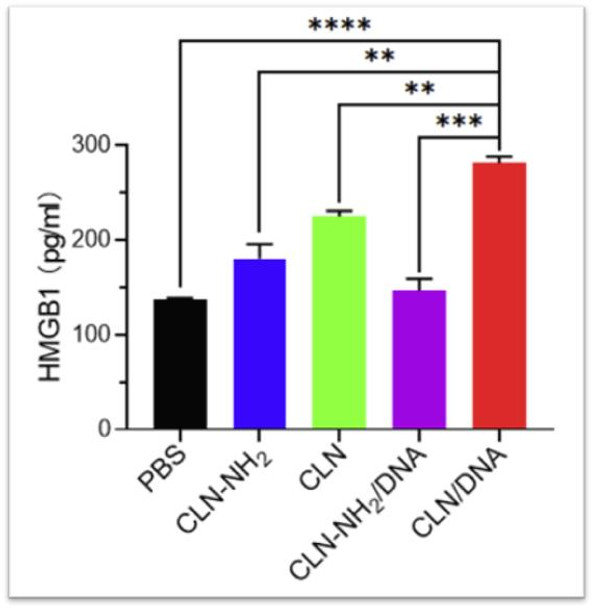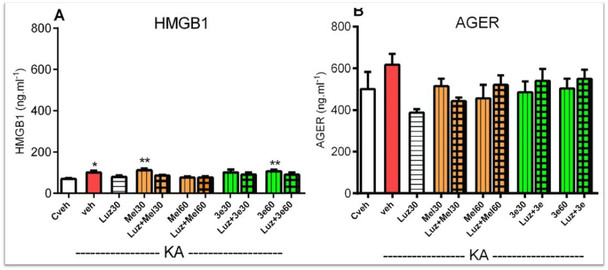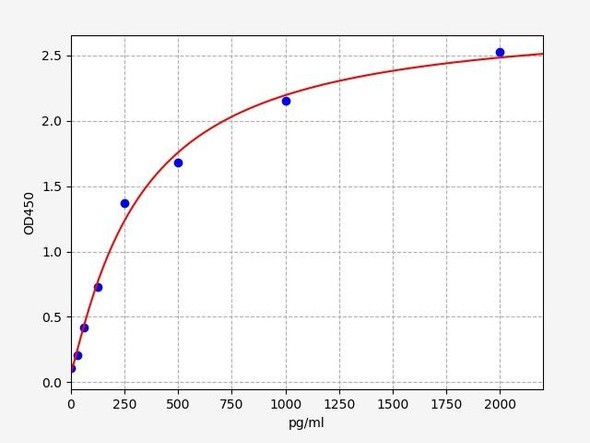Mouse HMGB1 ELISA Kit (MOFI00232)
- SKU:
- MOFI00232
- Product Type:
- ELISA Kit
- Size:
- 96 Assays
- Uniprot:
- P63158
- Sensitivity:
- 9.375pg/ml
- Range:
- 15.625-1000pg/ml
- ELISA Type:
- Sandwich
- Synonyms:
- Hmgb1, HMG-1, Amphoterin, high mobility group box 1, High mobility group protein 1, high-mobility group, nonhistone chromosomal protein 1, high-mobility group box 1, HMG-1, HMG1DKFZp686A04236, HMG3, SBP-1, Sulfoglucuronyl carbohydRate binding protein
- Reactivity:
- Mouse
- Research Area:
- Immunology
Description
Mouse HMGB1 ELISA Kit
HMGB1, a chromatin-binding protein and transcriptional regulator, acts as a damage associated molecular pattern (DAMP) when released extracellularly. It is a biomarker of inflammation, autoimmunity and cancers. The Assay Genie Mouse HMBG1 ELISA kit has been cited in various publications (view citations) whereby it is used as an indicator of active inflammation. It acts as a proinflammatory cytokine through binding to receptors TLR4 and RAGE and activating signaling pathways such as NF-κB and MAPK.
Key Features
| Save Time | Pre-coated 96 well plate | |
| Quick Start | Kit includes all necessary reagents | |
| Publication Ready | Reproducible and reliable results |
Overview
| Product Name: | Mouse HMGB1 ELISA Kit |
| Product Code: | MOFI00232 |
| Size: | 96 Assays |
| Alias: | Hmgb1, HMG-1, Amphoterin, high mobility group box 1, High mobility group protein 1, high-mobility group, nonhistone chromosomal protein 1, high-mobility group box 1, HMG-1, HMG1DKFZp686A04236, HMG3, SBP-1, Sulfoglucuronyl carbohydRate binding protein |
| Detection Method: | Sandwich ELISA |
| Application: | This immunoassay kit allows for the in vitro quantitative determination of Mouse Hmgb1 concentrations in serum plasma and other biological fluids. |
| Sensitivity: | 9.375pg/ml |
| Range: | 15.625-1000pg/ml |
| Storage: | 4°C for 6 months |
| Note: | For Research Use Only |
Additional Information
| Recovery | Matrices listed below were spiked with certain level of Mouse Hmgb1 and the recovery rates were calculated by comparing the measured value to the expected amount of Mouse Hmgb1 in samples.
| ||||||||||||||||||||
| Linearity: | The linearity of the kit was assayed by testing samples spiked with appropriate concentration of Mouse Hmgb1 and their serial dilutions. The results were demonstrated by the percentage of calculated concentration to the expected.
| ||||||||||||||||||||
| CV(%) | Intra Assay <8 Inter Assay <10 |
Kit Components
| Component | Quantity | Storage |
| ELISA Microplate (Dismountable) | 8x12 strips | 4°C for 6 months |
| Lyophilized Standard | 2 | 4°C/ -20°C |
| Sample/Standard Dilution Buffer | 20ml | 4°C |
| Biotin-labeled Antibody (Concentrated) | 120ul | 4°C (Protection from light) |
| Antibody Dilution Buffer | 10ml | 4°C |
| HRP-Streptavidin Conjugate (SABC) | 120ul | 4°C (Protect from light) |
| SABC Dilution Buffer | 10ml | 4°C |
| TMB Substrate | 10ml | 4°C (Protection from light) |
| Stop Solution | 10ml | 4°C |
| Wash Buffer (25X) | 30ml | 4°C |
| Plate Sealer | 5 | - |
Other materials required:
- Microplate reader with 450 nm wavelength filter
- Multichannel Pipette, Pipette, microcentrifuge tubes and disposable pipette tips
- Incubator
- Deionized or distilled water
- Absorbent paper
- Buffer resevoir
Protocol
*Note: Protocols are specific to each batch/lot. For the exact instructions please follow the protocol included in your kit.
Before adding to wells, equilibrate the SABC working solution and TMB substrate for at least 30 min at 37°C. When diluting samples and reagents, they must be mixed completely and evenly. It is recommended to plot a standard curve for each test.
| Step | Procedure |
| 1. | Set standard, test sample and control (zero) wells on the pre-coated plate respectively, and then, record their positions. It is recommended to measure each standard and sample in duplicate. Wash plate 2 times before adding standard, sample and control (zero) wells! |
| 2. | Aliquot 0.1ml standard solutions into the standard wells. |
| 3. | Add 0.1 ml of Sample / Standard dilution buffer into the control (zero) well. |
| 4. | Add 0.1 ml of properly diluted sample ( Human serum, plasma, tissue homogenates and other biological fluids.) into test sample wells. |
| 5. | Seal the plate with a cover and incubate at 37 °C for 90 min. |
| 6. | Remove the cover and discard the plate content, clap the plate on the absorbent filter papers or other absorbent material. Do NOT let the wells completely dry at any time. Wash plate X2. |
| 7. | Add 0.1 ml of Biotin- detection antibody working solution into the above wells (standard, test sample & zero wells). Add the solution at the bottom of each well without touching the side wall. |
| 8. | Seal the plate with a cover and incubate at 37°C for 60 min. |
| 9. | Remove the cover, and wash plate 3 times with Wash buffer. Let wash buffer rest in wells for 1 min between each wash. |
| 10. | Add 0.1 ml of SABC working solution into each well, cover the plate and incubate at 37°C for 30 min. |
| 11. | Remove the cover and wash plate 5 times with Wash buffer, and each time let the wash buffer stay in the wells for 1-2 min. |
| 12. | Add 90 µl of TMB substrate into each well, cover the plate and incubate at 37°C in dark within 10-20 min. (Note: This incubation time is for reference use only, the optimal time should be determined by end user.) And the shades of blue can be seen in the first 3-4 wells (with most concentrated standard solutions), the other wells show no obvious color. |
| 13. | Add 50 µl of Stop solution into each well and mix thoroughly. The color changes into yellow immediately. |
| 14. | Read the O.D. absorbance at 450 nm in a microplate reader immediately after adding the stop solution. |
Sample Preparation
When carrying out an ELISA assay it is important to prepare your samples in order to achieve the best possible results. Below we have a list of procedures for the preparation of samples for different sample types.
| Sample Type | Protocol |
| Serum | If using serum separator tubes, allow samples to clot for 30 minutes at room temperature. Centrifuge for 10 minutes at 1,000x g. Collect the serum fraction and assay promptly or aliquot and store the samples at -80°C. Avoid multiple freeze-thaw cycles. If serum separator tubes are not being used, allow samples to clot overnight at 2-8°C. Centrifuge for 10 minutes at 1,000x g. Remove serum and assay promptly or aliquot and store the samples at -80°C. Avoid multiple freeze-thaw cycles. |
| Plasma | Collect plasma using EDTA or heparin as an anticoagulant. Centrifuge samples at 4°C for 15 mins at 1000 × g within 30 mins of collection. Collect the plasma fraction and assay promptly or aliquot and store the samples at -80°C. Avoid multiple freeze-thaw cycles. Note: Over haemolysed samples are not suitable for use with this kit. |
| Urine & Cerebrospinal Fluid | Collect the urine (mid-stream) in a sterile container, centrifuge for 20 mins at 2000-3000 rpm. Remove supernatant and assay immediately. If any precipitation is detected, repeat the centrifugation step. A similar protocol can be used for cerebrospinal fluid. |
| Cell culture supernatant | Collect the cell culture media by pipette, followed by centrifugation at 4°C for 20 mins at 1500 rpm. Collect the clear supernatant and assay immediately. |
| Cell lysates | Solubilize cells in lysis buffer and allow to sit on ice for 30 minutes. Centrifuge tubes at 14,000 x g for 5 minutes to remove insoluble material. Aliquot the supernatant into a new tube and discard the remaining whole cell extract. Quantify total protein concentration using a total protein assay. Assay immediately or aliquot and store at ≤ -20 °C. |
| Tissue homogenates | The preparation of tissue homogenates will vary depending upon tissue type. Rinse tissue with 1X PBS to remove excess blood & homogenize in 20ml of 1X PBS (including protease inhibitors) and store overnight at ≤ -20°C. Two freeze-thaw cycles are required to break the cell membranes. To further disrupt the cell membranes you can sonicate the samples. Centrifuge homogenates for 5 mins at 5000xg. Remove the supernatant and assay immediately or aliquot and store at -20°C or -80°C. |
| Tissue lysates | Rinse tissue with PBS, cut into 1-2 mm pieces, and homogenize with a tissue homogenizer in PBS. Add an equal volume of RIPA buffer containing protease inhibitors and lyse tissues at room temperature for 30 minutes with gentle agitation. Centrifuge to remove debris. Quantify total protein concentration using a total protein assay. Assay immediately or aliquot and store at ≤ -20 °C |
| Breast Milk | Collect milk samples and centrifuge at 10,000 x g for 60 min at 4°C. Aliquot the supernatant and assay. For long term use, store samples at -80°C. Minimize freeze/thaw cycles. |
HMGB1 Background
What is HMGB1?
HMGB1 (High Mobility Group Box 1) is a highly conserved protein found in mammals that belongs to the high mobility group (HMG) box protein family. It was first identified as a DNA-binding protein that stabilizes nucleosome formation and regulates gene expression. However, subsequent research has revealed that HMGB1 also functions as an extracellular signaling molecule involved in inflammation, immunity, and tissue repair. HMGB1 is released by immune cells and injured tissues in response to various stimuli, including infection, injury, and inflammation.
HMGB1 Gene
The HMGB1 gene in mice is known as Hmgb1 and is located on chromosome 5. It consists of six exons that encode a protein of 171 amino acids. The gene is highly conserved among species, and the mouse Hmgb1 gene shares significant similarity with its human counterpart. The expression of Hmgb1 is regulated at transcriptional and post-transcriptional levels, and it is expressed in various cell types, including immune cells, neurons, and epithelial cells. Several pseudogenes of this gene have been discovered, and alternative splicing leads to the generation of several transcript variants that ultimately produce the identical protein.
HMGB1 Structure
HMGB1 protein is composed of two DNA-binding domains known as HMG boxes (A box and B box) and a C-terminal acidic tail. The HMG boxes facilitate binding to distorted DNA structures, such as bent or unwound DNA, and contribute to the protein's DNA-binding properties. The acidic tail is involved in protein-protein interactions and post-translational modifications. HMGB1 can exist in different redox states, with the fully reduced form being associated with its cytokine-like activity.
Predicted Structure of Mouse HMGB1. Source: Uniprot
HMGB1 Function
HMGB1 has diverse functions depending on its subcellular localization. Intracellularly, it acts as a nuclear architectural protein that helps regulate transcription, DNA repair, and chromatin remodeling. However, extracellularly, HMGB1 functions as a damage-associated molecular pattern (DAMP) molecule, activating immune responses. It acts as a cytokine-like molecule, binding to various cell surface receptors, including Toll-like receptors (TLRs) and the receptor for advanced glycation end products (RAGE), triggering signaling cascades that promote inflammation, cell migration, and tissue repair.
HMGB1 Clinical Significance
The clinical significance of HMGB1 is evident in various pathological conditions. It has been implicated in chronic inflammatory diseases, autoimmune disorders, cancer, and sepsis. HMGB1 released during tissue damage or infection can initiate and perpetuate inflammation, leading to tissue damage. It has also been associated with the progression and metastasis of various cancers, as it can promote tumor cell survival, angiogenesis, and immune evasion. In sepsis, HMGB1 contributes to the dysregulated immune response and organ dysfunction associated with this life-threatening condition. Therefore, HMGB1 is considered a potential therapeutic target for various diseases, and its inhibition or modulation could have clinical benefits.
Mouse HMGB1 Fact Sheet
| Gene Name | Hmgb1 |
| Gene ID | |
| Uniprot ID | |
| Full Name | High mobility group box 1 |
| Protein Family | HMGB family. |
Mouse HMGB1 ELISA Kit FAQs
Q: What is the purpose of the Mouse HMGB1 ELISA Kit?
The Mouse HMGB1 ELISA Kit is specifically designed for the quantitative detection of HMGB1 (High Mobility Group Box 1) protein levels in mouse samples. It enables researchers to accurately measure the concentration of HMGB1 in various biological samples such as serum, plasma, tissue homogenates, and cell culture supernatants and provides a reliable and sensitive tool for investigating the role of HMGB1 in inflammation, immunity, disease progression, and therapeutic studies.
Q: What sample types can be used with the Mouse HMGB1 ELISA Kit?
The Mouse HMGB1 ELISA Kit is designed to measure HMGB1 levels in various sample types, including serum, plasma, tissue homogenates, and cell culture supernatants. It offers versatility in experimental design, allowing researchers to analyze HMGB1 expression in different biological matrices and evaluate its release or accumulation under specific experimental conditions.
Q: Can the Mouse HMGB1 ELISA Kit be used with other species?
The Mouse HMGB1 ELISA Kit is specifically designed and optimized for the detection of HMGB1 in mouse samples. While it is primarily intended for use with mouse samples, it is possible that the kit may cross-react with HMGB1 from other species. However, it is important to validate the cross-reactivity or consider using species-specific ELISA kits for accurate results in non-mouse samples.
Q: Where can I find additional technical support or assistance with the Mouse HMGB1 ELISA kit?
For any technical inquiries or assistance regarding the Mouse HMGB1 ELISA kit, you can reach out to our team. They will be available to answer your questions and provide the necessary guidance to ensure a successful experiment.
Citations
| Cong et al. | Cationic Liposome/DNA Complexes Mediate Antitumor Immunotherapy by Promoting Immunogenic Tumor Cell Death and Dendritic Cell Activation | ACS Appl Mater Interfaces. 12(25):28047-28056 (2020) | PubMed: 32478501 |
| Li et al. | HDAC5 promotes intestinal sepsis via the Ghrelin/E2F1/NF-κB axis | FASEB J. (2021) | PubMed: 34125448 |
| Tchekalarova et al. | The Anticonvulsant Effect of a Novel Indole-Related Compound in the Kainate-Induced Status Epilepticus in Mice: The Role of the Antioxidant and Anti-inflammatory Mechanism | Neurochem Res. (2021) | PubMed: 34510375 |
| Wang et al. | The Host-Defense-Peptide-Mimicking Synthetic Polypeptides Effectively Enhance Antitumor Immunity through Promoting Immunogenic Tumor Cell Death | Macromol Biosci. (2021) | Pub Med: 34169661 |
Data from Citations
 | Released HMGB1 in culture supernatants measured with the Assay Genie HMGB1 ELISA (Cong et al.) |
 | HMGB1 levels measured with the Assay Genie HMGB1 ELISA kit (Li et al.) |
 | HMGB1 and RAGE values in hippocampus samples were quantified with mouse HMGB1 ELISA Kit and mouse AGER/RAGE ELISA Kit (Tchekalarova et al.) |
 | Released HMGB1 in culture supernatants measured with the Assay Genie HMGB1 ELISA (Wang et al.) |















